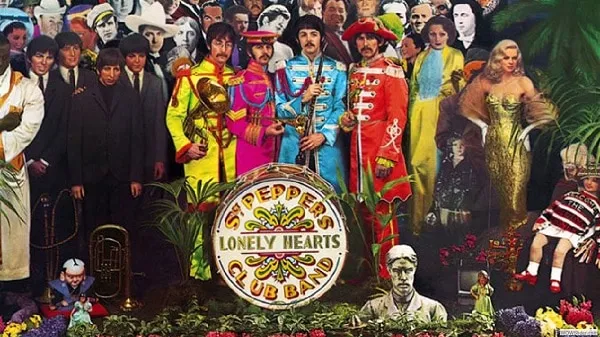
Videos by American Songwriter
By the time The Beatles settled in to write the songs that would make up their legendary 1967 album Sgt. Pepper’s Lonely Hearts Club Band, John Lennon and Paul McCartney’s songwriting partnership had drastically transformed from the early days when they would write songs face-to-face, trading lines. It was now far more common for one of them to write a song on his own and then bring it in so the other could edit, criticize, and maybe embellish upon the raw material provided.
In the case of Pepper’s monumental closing track “A Day In The Life,” the collaboration came from the melding of seemingly disparate parts of songs that the two had written separately. As Lennon told Playboy shortly before his death in 1980, “I was reading the paper one day and noticed two stories. One was about the Guinness heir who killed himself in a car. That was the main headline story. He died in London in a car crash. On the next page was a story about four thousand potholes in the streets of Blackburn, Lancashire, that needed to be filled.”
The Top 20 Beatles Songs, A Day In The Life
“Paul’s contribution was the beautiful little lick in the song, ‘I’d love to turn you on,’ that he’d had floating around in his head and couldn’t use,” Lennon continued. McCartney was also responsible for the middle portion of the song, the “Woke up, fell out of bed” section that reroutes Lennon’s dreamy acoustic wandering into a purposeful jaunt. No discussion of “A Day In The Life” is complete without mention of the ingenious production of George Martin, who took McCartney’s avant-garde orchestral ideas in the connecting parts and brought them all together into an instantly accessible recording. Note how when Lennon returns for the final verse, the rhythm from the bridge is underneath him, the two unique sections brought seamlessly together.
It’s tempting to write off Lennon’s retelling of the car accident (which claimed the life of young Tara Browne, who ran in the same circles as many pop stars of the day) as mere reportage. A closer look reveals a subtly slippery take on the situation, as the narrator cycles through emotions like envy, sorrow, and mirth in what seems to be an attempt to come to terms with a senseless tragedy.
In the third verse, Lennon switches gears to talk about a film he just saw (or “sar” as he pronounces it.) This film fails to hold the attention of the audience drawn in by the car crash. While this verse is likely Lennon’s reference to his supporting role in the farce How I Won The War, it could also be read as the unspoken declaration of the younger generation’s weariness for war stories.
McCartney’s middle section displays his effortless knack for melodies than ingratiate themselves to listeners and lyrics that subtly resonate. His harried latecomer doesn’t sound all that dissimilar from millions of folks struggling to get through their morning routines. Yet the gorgeous musical section that immediately follows the line “And somebody spoke and I went into a dream” seems to suggest a yearning to shed the daily drudgery, to transcend it somehow.
The Top 20 Beatles Songs: #2, Something
The final verse about the deteriorating road conditions in Lancashire allows Lennon to make small talk about the kind of mind-numbing minutiae that dominates most conversations. After making his little joke about the Albert Hall, he returns to that mesmerizing refrain: “I’d love to turn you on.” This was a time in their careers when drugs certainly played a role in the group’s songwriting, but, as McCartney remembered in Beatles In Their Own Words, this line had a bit more on its mind. “This was the only one on the album written as a deliberate provocation to people,” he said. “But what we really wanted was to turn you on to the truth rather than just bloody pot.”
Contrarians over the years (Lennon included) have pointed out that Sgt. Pepper’s doesn’t hold up as a concept album since the whole faux-concert idea derails about three songs into the proceedings. Those folks are missing the underlying connector in this collection of songs, which is the way the lyrics detail routine, even mundane slices of life while the stunning music jolts these tales into a fantastical dimension. From the bashful suitor of “Lovely Rita” to the local circus in “Being For The Benefit Of Mr. Kite” to the runaway in “She’s Leaving Home,” they’re all stories that could have been lifted from the local paper or recounted in gossip in the street. In the hands of The Beatles, they sound endlessly fascinating and revelatory.
“A Day In The Life” is the epitome of this phenomenon. In the closing moments, the crazed orchestral crescendo might just reveal the meaning of life if we could ever corral and contain it. And with that final piano chord, the Beatles shatter the overhanging, smothering drear of the everyday. Transcendence accomplished.

One Comment
Leave a Reply